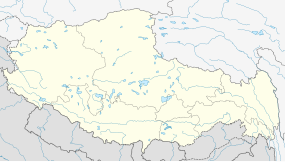Tsaparang

Tsaparang, the ruins of the ancient capital of Guge kingdom
|
|
| Location | Zanda, Ngari, TAR, China |
|---|---|
| Region | Tibet |
| Coordinates | 31°27′59″N 79°40′14″E / 31.46639°N 79.67056°ECoordinates: 31°27′59″N 79°40′14″E / 31.46639°N 79.67056°E |
| Altitude | 3,800 m (12,467 ft) |
| History | |
| Founded | 9th or 10th century CE |
| Abandoned | 1680 CE |
Tsaparang was the capital of the ancient kingdom of Guge in the Garuda Valley, through which the upper Sutlej River flows, in Ngari Prefecture (Western Tibet) near the border of Ladakh. It is 278 km south-southwest of Senggezangbo Town and 26 km west of the 11th-century monastery at Thöling, and not far west of Mount Kailash and Lake Manasarovar. The Tsaparang Dzong was located here. Nearby is the Bon monastery of Gurugem.
Tsaparang is a huge fortress perched on a pyramid-shaped rock rising about 500 to 600 feet (152 to 183 m) at the end of a long narrow spur. It contains numerous tunnels and caves that have been carved out of the rock. At its base was a village where the common people lived. Above them were two public temples - the Lhakhang Marpo (Red Chapel) and the Lhakhang Karpo (White Chapel), and quarters for the monks. Further up, ascending a twisting stone staircase in a tunnel, were the royal quarters, and at the very top, the summer palace.
TV Presenter and historian Michael Wood, in the "Shangri-La" episode of the BBC TV/PBS documentary series In Search of Myths and Heroes, suggested that Tsaparang was the historical origin of the legend of Shangri-La, and that its two great temples were once home to the kings of Guge in modern Tibet.
According to some accounts, Tsaparang was made the capital of a Kingdom of Guge by Namde Wosung, one of the sons of the Langdharma the anti-Buddhist king of Tibet 838-841 CE, after Langdharma was assassinated. The Tibetan Empire was then plunged into civil war and split into a number of independent kingdoms. Other accounts say that two of Langdharma's grandsons fled to Western Tibet about 919 CE. The eldest one, Nyima Gon, established himself at Purang and conquered a large area including Ladakh and parts of Spiti. After his death his kingdom was split up between his three sons into the kingdoms of Guge, Purang, and Maryul (= Ladakh).
...
Wikipedia

